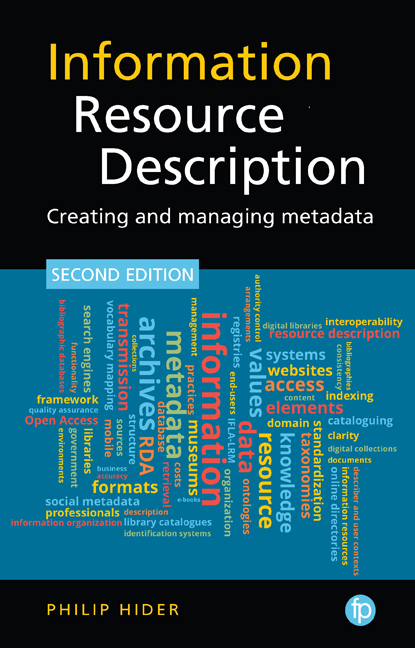Book contents
- Frontmatter
- Dedication
- Contents
- List of figures and tables
- Preface to the First Edition
- Preface to the Second Edition
- List of abbreviations
- 1 Definitions and scope
- 2 Information resource attributes
- 3 Tools and systems
- 4 Metadata sources
- 5 Metadata quality
- 6 Sharing metadata
- 7 Metadata standards
- 8 Vocabularies
- 9 The future of metadata
- Further reading
- List of metadata standards
- Index
3 - Tools and systems
Published online by Cambridge University Press: 24 September 2019
- Frontmatter
- Dedication
- Contents
- List of figures and tables
- Preface to the First Edition
- Preface to the Second Edition
- List of abbreviations
- 1 Definitions and scope
- 2 Information resource attributes
- 3 Tools and systems
- 4 Metadata sources
- 5 Metadata quality
- 6 Sharing metadata
- 7 Metadata standards
- 8 Vocabularies
- 9 The future of metadata
- Further reading
- List of metadata standards
- Index
Summary
Introduction
In the previous chapter we talked about how the various attributes of information resources might be of interest to users, and are thus commonly described as metadata elements for use in information organization and retrieval systems. These systems provide intellectual as well as often physical access to large numbers of resources in a much more efficient and effective way than would otherwise be the case. Although some information retrieval systems are based mainly on the content of information resources, most make use of some elements of metadata, and those that are prime examples of information organization systems, such as library catalogues and archival finding aids, rely heavily on it. This chapter will emphasise the latter.
In Chapter 1 we noted the three basic ways in which information resources, like other resources, can be organised in order to improve (effective) access to them: they can be arranged, labelled and indexed. These operations are by no means mutually exclusive, and many information retrieval systems make use of all three techniques. However, we shall begin by considering those systems that do not involve any form of index and that, instead, are based solely on the arrangement and labelling of the items themselves.
Arrangements
Things have been arranged by people for many thousands of years, and information resources have been arranged for as long as there have been collections of them. For our purposes, arrangements are designed to help people look for information resources and look through information resource collections. Just as information resources have countless attributes that can be recorded in any number of ways, so too are there all sorts of ways to arrange them. Sometimes it may actually be best to retain the resources’ ‘original order’, which is an important archival principle that we will come back to shortly. Whatever the arrangement, it is critical that prospective resource users need to know the basis of it. Arrangements can be made across one, two or three dimensions. A very common system of arrangement is of a certain order across one dimension, as in ‘by author’.
- Type
- Chapter
- Information
- Information Resource DescriptionCreating and Managing Metadata, pp. 43 - 72Publisher: FacetPrint publication year: 2018



